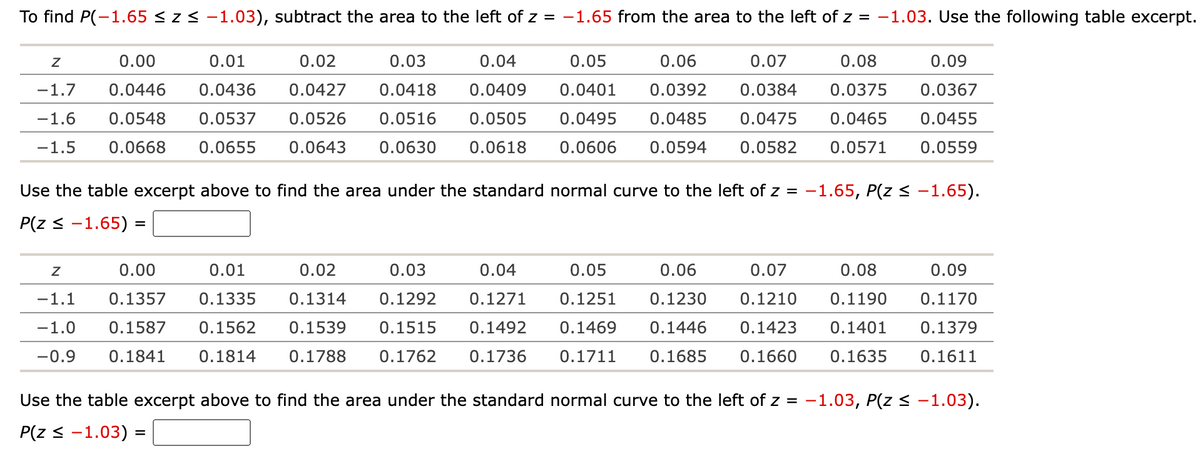To find P(-1.65 ≤ z≤ -1.03), subtract the area to the left of z = -1.65 from the area to the left of z = -1.03. Use the following table excerpt. Z 0.07 0.09 0.00 -1.7 0.0446 0.01 0.0436 -1.6 0.0548 0.0537 0.03 0.04 0.0418 0.0409 0.0516 0.0505 0.02 0.0427 0.0526 -1.5 0.0668 0.0655 0.0643 0.0630 0.0618 0.0606 0.0594 0.0582 0.0571 0.05 0.0401 0.0495 0.06 0.0392 0.08 0.0384 0.0375 0.0367 0.0485 0.0475 0.0465 0.0455 0.0559 Use the table excerpt above to find the area under the standard normal curve to the left of z = -1.65, P(Z < -1.65). P(Z < -1.65) = Z 0.00 0.01 0.02 0.03 -1.1 0.1357 0.1335 0.1314 0.1292 -1.0 0.1587 0.1562 0.1539 0.1515 -0.9 0.1841 0.1814 0.1788 0.1762 0.1736 0.1711 0.1685 0.1660 0.1635 0.1611 0.04 0.1271 0.1492 0.05 0.06 0.1251 0.1230 0.1469 0.1446 0.07 0.08 0.1210 0.1190 0.1423 0.1401 0.09 0.1170 0.1379 Use the table excerpt above to find the area under the standard normal curve to the left of z = -1.03, P(Z < -1.03). P(Z ≤ -1.03) =
To find P(-1.65 ≤ z≤ -1.03), subtract the area to the left of z = -1.65 from the area to the left of z = -1.03. Use the following table excerpt. Z 0.07 0.09 0.00 -1.7 0.0446 0.01 0.0436 -1.6 0.0548 0.0537 0.03 0.04 0.0418 0.0409 0.0516 0.0505 0.02 0.0427 0.0526 -1.5 0.0668 0.0655 0.0643 0.0630 0.0618 0.0606 0.0594 0.0582 0.0571 0.05 0.0401 0.0495 0.06 0.0392 0.08 0.0384 0.0375 0.0367 0.0485 0.0475 0.0465 0.0455 0.0559 Use the table excerpt above to find the area under the standard normal curve to the left of z = -1.65, P(Z < -1.65). P(Z < -1.65) = Z 0.00 0.01 0.02 0.03 -1.1 0.1357 0.1335 0.1314 0.1292 -1.0 0.1587 0.1562 0.1539 0.1515 -0.9 0.1841 0.1814 0.1788 0.1762 0.1736 0.1711 0.1685 0.1660 0.1635 0.1611 0.04 0.1271 0.1492 0.05 0.06 0.1251 0.1230 0.1469 0.1446 0.07 0.08 0.1210 0.1190 0.1423 0.1401 0.09 0.1170 0.1379 Use the table excerpt above to find the area under the standard normal curve to the left of z = -1.03, P(Z < -1.03). P(Z ≤ -1.03) =
Algebra: Structure And Method, Book 1
(REV)00th Edition
ISBN:9780395977224
Author:Richard G. Brown, Mary P. Dolciani, Robert H. Sorgenfrey, William L. Cole
Publisher:Richard G. Brown, Mary P. Dolciani, Robert H. Sorgenfrey, William L. Cole
Chapter7: Applying Fractions
Section7.1: Ratios
Problem 25WE
Related questions
Question

Transcribed Image Text:To find P(-1.65 ≤ z ≤ -1.03), subtract the area to the left of z = -1.65 from the area to the left of z = -1.03. Use the following table excerpt.
0.05
0.06
0.0401 0.0392
0.07
0.08
0.09
0.0384 0.0375 0.0367
Z
0.00
-1.7 0.0446
-1.6 0.0548
-1.5
0.01
0.02
0.03
0.04
0.0436 0.0427 0.0418 0.0409
0.0537 0.0526 0.0516 0.0505
0.0668 0.0655 0.0643 0.0630 0.0618
0.0475 0.0465 0.0455
0.0495 0.0485
0.0606 0.0594 0.0582 0.0571 0.0559
Use the table excerpt above to find the area under the standard normal curve to the left of z = -1.65, P(Z ≤ -1.65).
P(Z ≤ -1.65) =
Z
0.00
0.01
-1.1 0.1357 0.1335
-1.0
0.02
0.03
0.1314 0.1292
0.1515
0.04
0.1271
0.1492
0.05
0.06
0.07
0.1251 0.1230 0.1210
0.1469 0.1446
0.08
0.1190
0.1423 0.1401 0.1379
0.09
0.1170
0.1587 0.1562 0.1539
0.1841 0.1814 0.1788 0.1762 0.1736 0.1711 0.1685 0.1660 0.1635 0.1611
-0.9
Use the table excerpt above to find the area under the standard normal curve to the left of z = -1.03, P(Z < -1.03).
P(Z ≤ -1.03) =
Expert Solution
This question has been solved!
Explore an expertly crafted, step-by-step solution for a thorough understanding of key concepts.
This is a popular solution!
Trending now
This is a popular solution!
Step by step
Solved in 3 steps

Recommended textbooks for you

Algebra: Structure And Method, Book 1
Algebra
ISBN:
9780395977224
Author:
Richard G. Brown, Mary P. Dolciani, Robert H. Sorgenfrey, William L. Cole
Publisher:
McDougal Littell

Elementary Geometry For College Students, 7e
Geometry
ISBN:
9781337614085
Author:
Alexander, Daniel C.; Koeberlein, Geralyn M.
Publisher:
Cengage,

Algebra & Trigonometry with Analytic Geometry
Algebra
ISBN:
9781133382119
Author:
Swokowski
Publisher:
Cengage

Algebra: Structure And Method, Book 1
Algebra
ISBN:
9780395977224
Author:
Richard G. Brown, Mary P. Dolciani, Robert H. Sorgenfrey, William L. Cole
Publisher:
McDougal Littell

Elementary Geometry For College Students, 7e
Geometry
ISBN:
9781337614085
Author:
Alexander, Daniel C.; Koeberlein, Geralyn M.
Publisher:
Cengage,

Algebra & Trigonometry with Analytic Geometry
Algebra
ISBN:
9781133382119
Author:
Swokowski
Publisher:
Cengage

Mathematics For Machine Technology
Advanced Math
ISBN:
9781337798310
Author:
Peterson, John.
Publisher:
Cengage Learning,